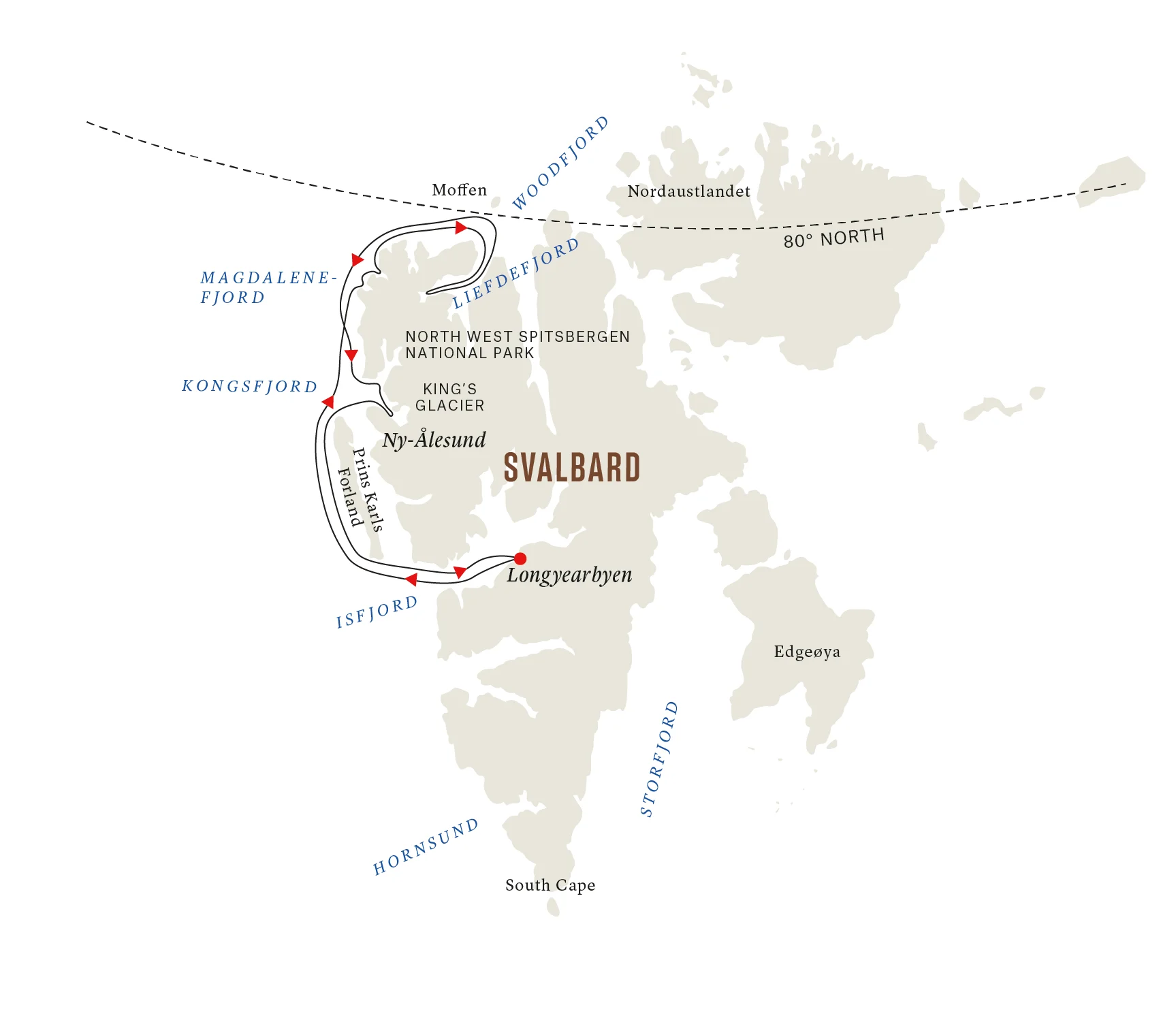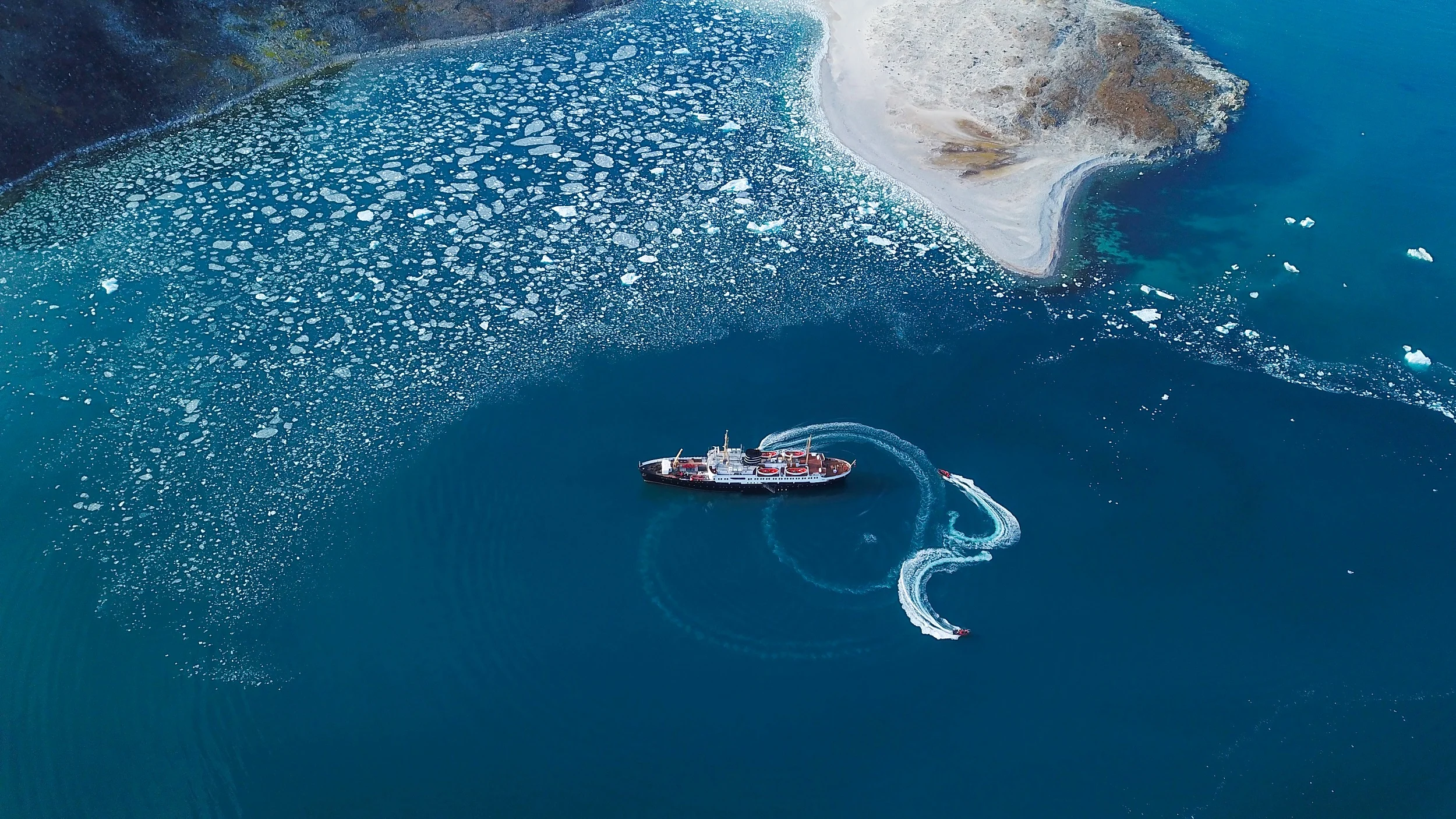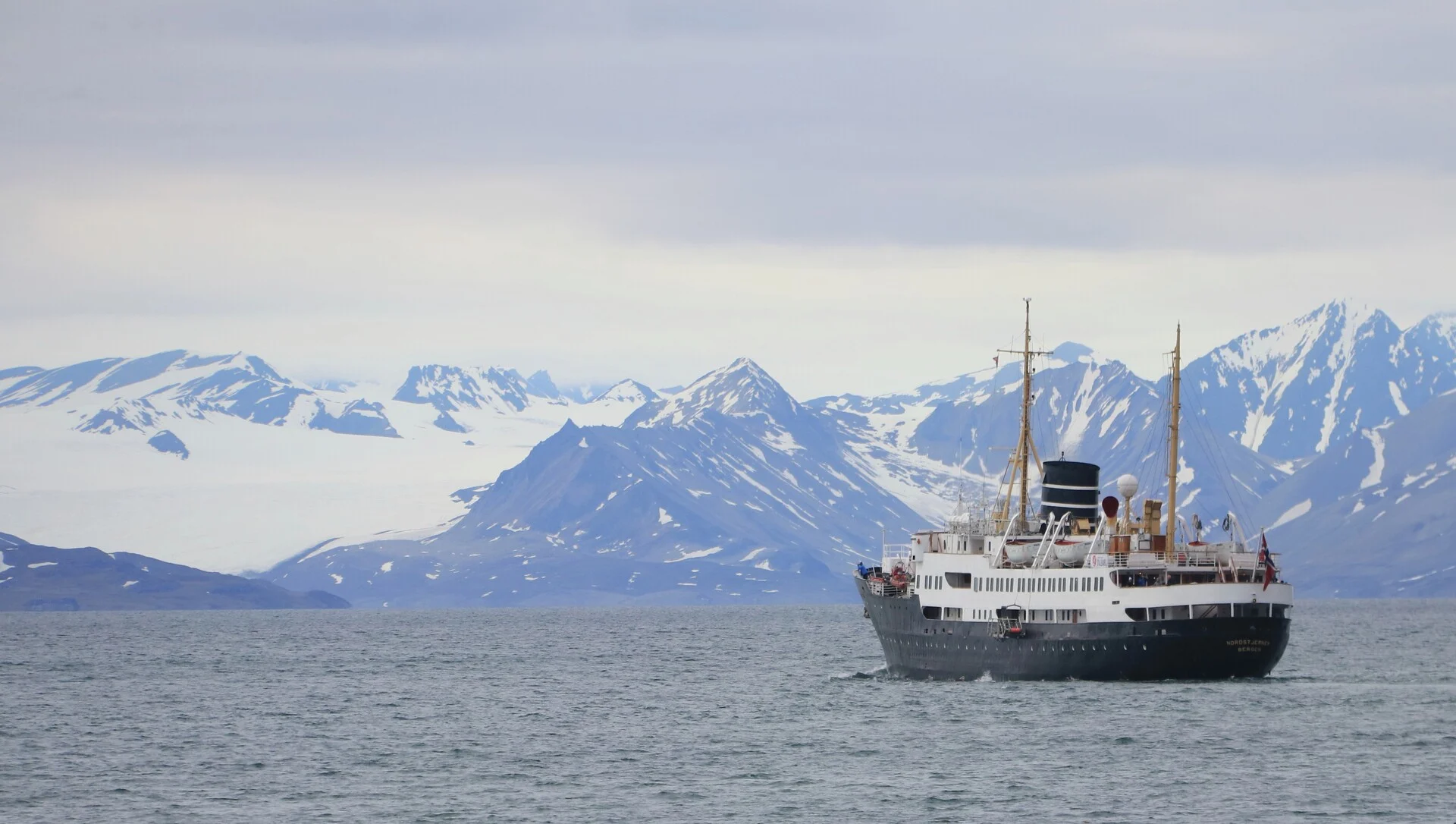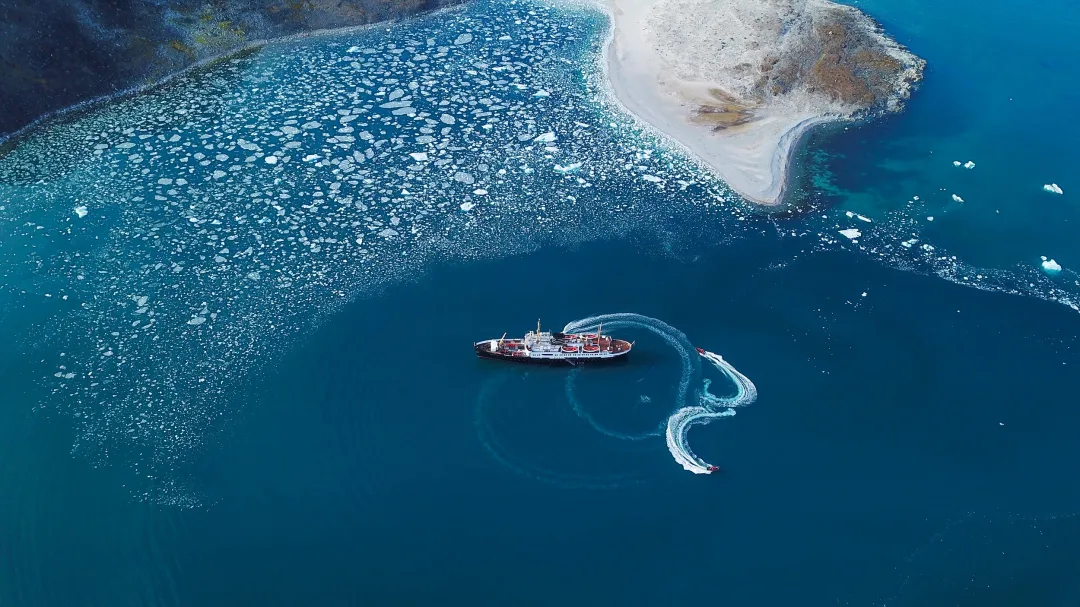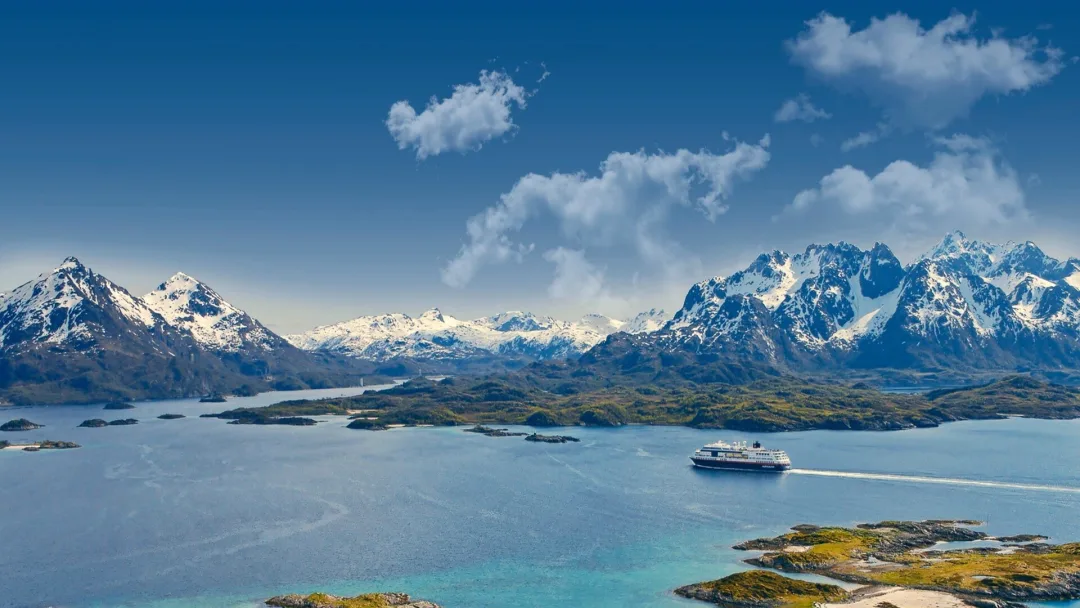Day 1
Mining history and Arctic nature
Mining history and Arctic nature
LongyearbyenWelcome to the roof of the world! From Longyearbyen airport, a transfer brings you to the town itself, nestled on the banks of a large, sweeping fjord. Longyearbyen is the largest settlement in Svalbard, though the 2,000 inhabitants here are outnumbered by snowmobiles.
Originally a coal mining colony, today it is a hub for adventure travellers, as well as scientists and engineers attached to local research projects, like the famous Global Seed Vault.
Depending on when you arrive in Longyearbyen and check in to your hotel, you might have time to head to the aptly named North Pole Expedition Museum. There, you can immerse yourself in Svalbard’s polar exploration history with old newspapers, photos, postcards, several hours of original expedition film footage, and quirky historical artefacts. You could also visit the Svalbard Brewery and enjoy a tasting session of beers brewed in the Arctic.
In the evening you’ll enjoy a light dinner at a local restaurant before spending the night at a Longyearbyen hotel, which offers modern comforts in historical surroundings.

Day 2
Settlements of the Far North
Settlements of the Far North
Longyearbyen, IsfjordAfter breakfast, you can take the morning to relax and explore this quaint town. Maybe you’ll encounter the Svalbard reindeer that are often seen walking around Longyearbyen, minding their own business. Although wild, you’ll find them quite curious and tame.
After lunch in one of the town’s restaurants, bring your bags to the bus and enjoy a guided tour that includes a visit to the Svalbard Museum. Here, you can find out all about the history, geology, and wildlife of the archipelago. Afterwards, we’ll pay a visit to Camp Barentz, where you’ll learn about polar bears. While you’re there, keep an eye out for reindeer, grouse, and foxes.
The historic MS Nordstjernen awaits at the harbour. Built in 1956, it’s one of our most beloved and longest-serving vessels. Despite modernisation for exclusive Arctic sailing in 2000 and 2013, MS Nordstjernen has retained its traditional Atlantic ship aura and offers a timeless experience not found on many other vessels.
After you settle in, we set sail in the Isfjord, the most prominent fjord system in the Svalbard archipelago. Branching out to many smaller fjords, it forms a lush and beautiful system rich in wildlife and vegetation. Prepare to see majestic glacier fronts and immense U-shaped valleys carved out of the mountains by giant glaciers some 10,000 years ago.
To the north of the fjord, look out for Alkhornet, an imposing example of carbonate rock, with a horn-shaped mount at its peak. Naturally, the surrounding wildlife has conquered it. This region is home to Arctic fox, Svalbard reindeer, and colonies of guillemots and kittiwakes.

Day 3
Into the Svalbard wilderness
Into the Svalbard wilderness
Magdalenefjord and the North West CornerLeaving behind what little civilisation there is, we now enter full exploration mode. In these beautiful yet remote areas, there is no internet, nor are there telephone masts to provide a mobile phone signal. Free from emails and text messages, you can enjoy a rare opportunity to disconnect and detox from the modern world. It’s time to really get back in sync with what truly matters.
Spitsbergen means “pointy mountains”. If there’s one place that embodies that definition more than others, it’s Magdalenefjord. Framed by spectacular views of jagged mountain peaks and glaciers, this breathtaking fjord has an Alpine feel to it, despite its remote location in the far north-west. The reflection of snow-capped mountains perfectly mirrored in the waters’ glassy surface is undoubtedly one of Svalbard’s most iconic sights.
We arrive in the morning and hope to make a landing to explore this wonderful Arctic wilderness. If we’re successful, you’ll be setting foot on land with a rich history of exploration – Magdalenefjord has lured explorers for centuries. Arctic explorer Willem Barents famously came here in 1596, naming it "Tusk Bay" because of the walrus tusks he found here.
The beautiful beach is peppered with evidence of a whaling station from the 17th Century, with blubber ovens, a cemetery of 130 graves, and a memorial to the whalers.
Long before explorers set foot on Magdalenefjord, the stunning views were the preserve of wildlife. Today, the scree slopes are breeding grounds for large numbers of Little Auks, and you might also see Arctic Terns, Skuas, Eider Ducks, and Barnacle Geese. In the summer months, the surrounding waters host minke and beluga whales. Scan for seals on the floating sea ice and, if it’s your lucky day, you might catch a glimpse of a polar bear.

Day 4
Scanning for polar wildlife
Scanning for polar wildlife
Woodfjord, Liefdefjord, Moffen, and 80°NorthSvalbard is a land of contrasts. Within Woodfjord’s vast fjord system is a varied and unique landscape featuring striking red mountains of Devonian sandstone, cone-shaped remnants of three volcanoes, and thermal springs.
Woodfjord’s beautiful tundra is rich in flora enhanced by the oxidised soil in the Old Red areas. Hiking here will reward you with gorgeous views of purple saxifrage and spider plants.
The stunning views continue in Liefdefjord, which means "The Love Fjord" in English. It is possibly named after a Dutch ship, but it could also very well be because of its jaw-dropping views. Rolling red hills give way to snow-capped mountains inland.
The area around Liefdefjord is also a great place to scan for wildlife. The sights and sounds of thousands of sea birds like kittiwakes, terns and eiders fill the sky. As ever, the weather and ice will determine where we land and what activities we’ll do.
If the conditions are favourable, we plan to sail above 80° North, bringing you within 600 nautical miles of the North Pole. This far north, the sun is visible for 24 hours. Under the glorious Midnight Sun, you’ll have even more time to enjoy the stunning views from the deck.
Directly above 80° North is Moffen, a stark, gravely island known for its walrus population. Large numbers of them are known to gather at the southern tip of the island. Seeing these huge marine mammals frolic on the shore is always a highlight. Our approach to the island will adhere to the 300m exclusion zone to avoid disturbing this vulnerable animal.

Day 5
Fjords, glaciers and research
Fjords, glaciers and research
Ny-ÅlesundAlso known as Kong’s Fjord or King’s Bay, Kongsfjord is the largest fjord on the north-west coast of Spitsbergen. Two imposing glaciers, Kongsvegen and the colossal Kongsbreen, watch over the entrance of the fjord. As we sail silently, you might hear the tell-tale creaks and groans of chunks of glacier ice about to plunge into the sea. Framed by picturesque mountain formations, it’s undoubtedly one of Svalbard’s most scenic spots.
Hiking in the lush tundra will allow you to observe birds in a pristine environment. Northern Fulmars, Black-legged Kittiwakes, Atlantic Puffins and guillemots are just some of the species found here in the summer months. A bird sanctuary consisting of about ten islands lies at the inner end of the fjord, and supports breeding populations of protected species such as Pink-footed Geese and Common Eider.
Later, we dock at the former mining settlement of Ny-Ålesund. At 78º 55’ N, this is one of the world’s northernmost year-round communities. Transformed into an international science centre, you’ll find a fair number of research stations from various countries dedicated to the study of glaciology, wildlife, and climate change.
You’ll unearth some fascinating history as you explore the settlement, which today hosts roughly 30-35 residents. Ny-Ålesund and its surrounding area are home to a large concentration of protected buildings and cultural artefacts left by Svalbard’s former settlers.
This tiny settlement is synonymous with historical attempts to reach the North Pole. Discover rich explorer history in the museum and see the mooring mast of Roald Amundsen’s airship “Norge”, before sending a postcard from the northernmost post box in the world!

Day 6
Flying home from Svalbard
Flying home from Svalbard
LongyearbyenToday marks the end of your Arctic adventure around Svalbard. As you wind down from your voyage, you’ll have some time to look back on all your new memories, still holding onto that elated feeling of having just been quite literally near the “top of the world”.
After saying goodbye to the ship and its crew, you’ll take a transfer to the airport for your flight home.
If you have time, grab some souvenirs from the local shops before leaving. A toasty Svalbard sweater or a box of local handmade chocolates would make a wonderful gift for family and friends. Svalbard is a duty-free zone and Longyearbyen has a selection of sports and outdoor clothing shops, so you could stock up on supplies for your next voyage.
Whatever’s next for you, we wish you a safe onward journey and look forward to seeing you again!
